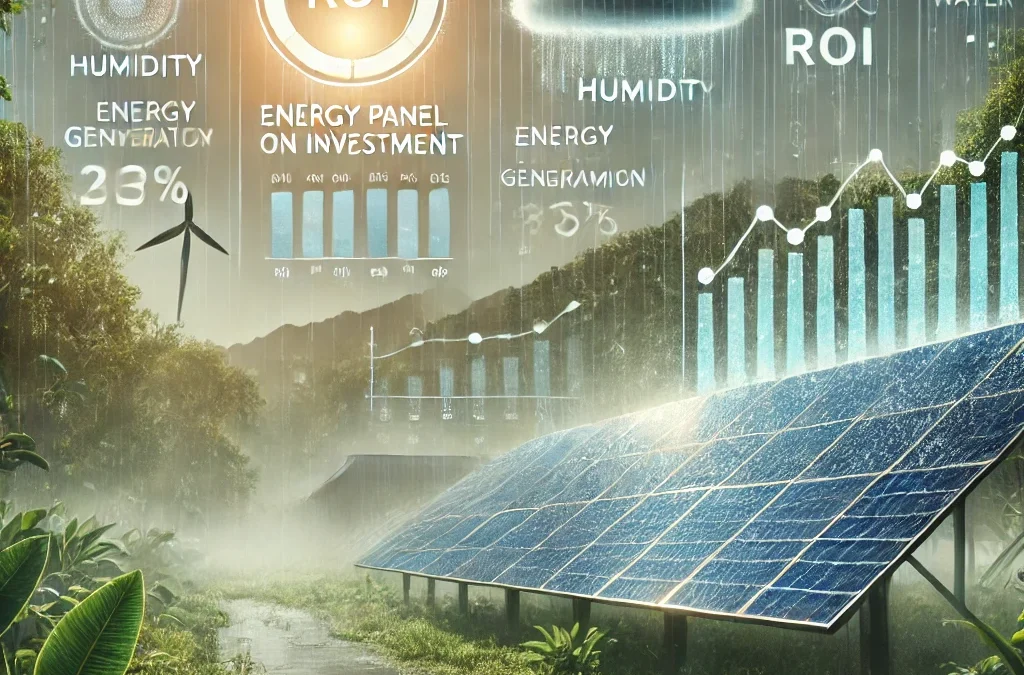Solar panel efficiency can be affected by various environmental factors, including humidity. In humid areas, certain conditions may influence the performance of solar panels, but with proper system design and maintenance, solar panels can still provide a strong return on investment (ROI). Here’s how humidity impacts solar panel efficiency and ROI:
1. How Humidity Affects Solar Panel Efficiency
1. Condensation & Water Film
Early morning dew or post-rain moisture can form a thin film on solar panels, reducing the amount of sunlight that penetrates the surface and reaches the photovoltaic (PV) cells. This temporarily lowers energy output.
2. More Dirt & Grime
Moisture attracts dust, pollen, salt, and even mold spores. These can stick to the panels and block sunlight. Without regular cleaning, this build-up can reduce efficiency by up to 15% over time.
3. Heat-Related Efficiency Loss
Humidity often comes hand-in-hand with high temperatures. For every 1°C above 25°C, solar panel output can drop by 0.3–0.5%. In hot, humid areas, this can add up quickly—especially during peak summer.
4. Accelerated Panel Degradation
In regions with extreme humidity, lower-tier panels may degrade faster if they lack moisture-resistant seals. However, Tier 1 solar panels are tested for such conditions and come with durability certifications like IEC 61701 (salt mist corrosion test).
2. Solutions to Optimize Efficiency in Humid Areas
- Anti-Reflective Coatings: Panels with anti-reflective or hydrophobic coatings can help repel water and reduce moisture build-up, ensuring that more sunlight reaches the cells.
- Regular Cleaning: Implementing a cleaning schedule in areas with high humidity can help keep dust, dirt, and other particles from accumulating on the panels, maintaining their efficiency.
- Ventilation: Proper ventilation around the solar panel installation helps to reduce heat build-up, allowing the panels to operate closer to their optimal temperature.
- Choosing the Right Panels: High-quality, Tier 1 solar panels are designed to withstand harsh weather conditions, including humidity, without degrading quickly. Look for panels with strong warranties and durability ratings (such as IEC 61701 certification for salt mist corrosion if the area is coastal).
3. Return on Investment (ROI) for Solar Panels in Humid Areas
Even in humid climates, solar panels can offer an attractive ROI, especially with rising electricity costs and government incentives. Here’s how to calculate and maximize ROI in these conditions:
Step-by-Step ROI Calculation
A. Initial Costs:
- Panel Cost: Cost of purchasing and installing solar panels (typically in $/watt).
- Installation Costs: Cost of mounting, wiring, and connecting to the grid.
- Maintenance Costs: Budget for regular cleaning and maintenance, which might be higher in humid areas.
Total Initial Investment = Panel Cost + Installation Cost + Maintenance Cost
B. Energy Production:
- Average Annual Energy Output: This depends on factors like the number of sunlight hours, local temperature, and efficiency losses due to humidity.
- In humid areas, you may assume a 5-10% efficiency reduction compared to drier climates, so adjust energy production estimates accordingly.
- Energy Production= Peak Output × Sunlight Hours Per Day × 365 × Panel Efficiency
C. Energy Savings:
- Multiply the energy production by the local electricity rate to determine how much you’ll save each year.
- Annual Savings = Energy Production × Local Electricity Rate
D. Payback Period:
- The payback period is the time it takes for your energy savings to cover the initial investment.
- Payback Period = Total Initial Investment /Annual Savings
E. ROI:
- To calculate ROI over the expected lifespan of the solar panels (typically 25-30 years), use the following formula:
- ROI =Total Savings Over Lifetime − Initial Investment / Initial Investment × 100
4. Factors to Consider for ROI in Humid Areas
- Incentives and Subsidies: Government incentives, such as tax credits or feed-in tariffs, can significantly boost ROI. Some countries and regions offer higher subsidies in areas with challenging climates to encourage renewable energy adoption.
- Rising Energy Costs: As electricity costs rise, the ROI on solar panel installations improves. Even if your panels are slightly less efficient in humid areas, the cost of conventional energy sources will likely continue to increase, making solar a financially smart choice.
- Energy Storage: Adding battery storage to your solar system allows you to store excess energy generated during peak sunlight hours for later use, further maximizing ROI, especially if you’re in an area with high electricity prices.
5.Calculating and Enhancing ROI in Humid Areas
Despite the potential efficiency reductions due to humidity, solar panels can still yield a favorable ROI. Here’s how to assess and improve it:
- Initial Investment:
- Panel and Installation Costs: Includes the purchase and setup expenses.
- Maintenance Budget: Allocate funds for regular cleaning and upkeep, which may be higher in humid regions.
- Energy Production Estimates:
- Adjusted Output: Factor in a potential 5-10% efficiency reduction due to humidity when estimating annual energy production.
- Financial Incentives:
- Government Programs: Research local incentives, such as tax credits or rebates, which can significantly offset initial costs. For example, the Federal Solar Tax Credit offers a 30% deduction on installation expenses.
- Net Metering:
- Energy Credits: Inquire about net metering policies that allow you to sell excess energy back to the grid, enhancing financial returns.
- Energy Storage Solutions:
- Battery Systems: Incorporating energy storage can optimize the use of generated power, especially during peak demand times, further improving ROI.
Conclusion
Solar systems in humid areas (like; solar solutions in Guwahati) is a cost-effective and eco-friendly choice. With proper maintenance and quality panels, you can overcome humidity challenges, enjoy energy independence, lower bills, and achieve excellent ROI while contributing to a sustainable future.

